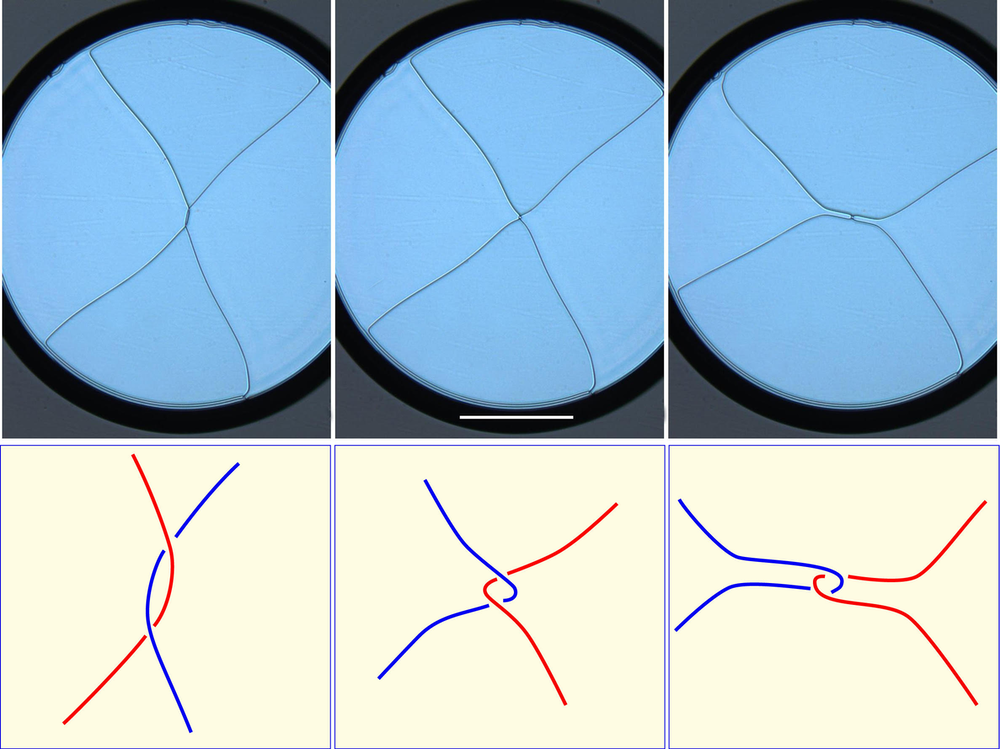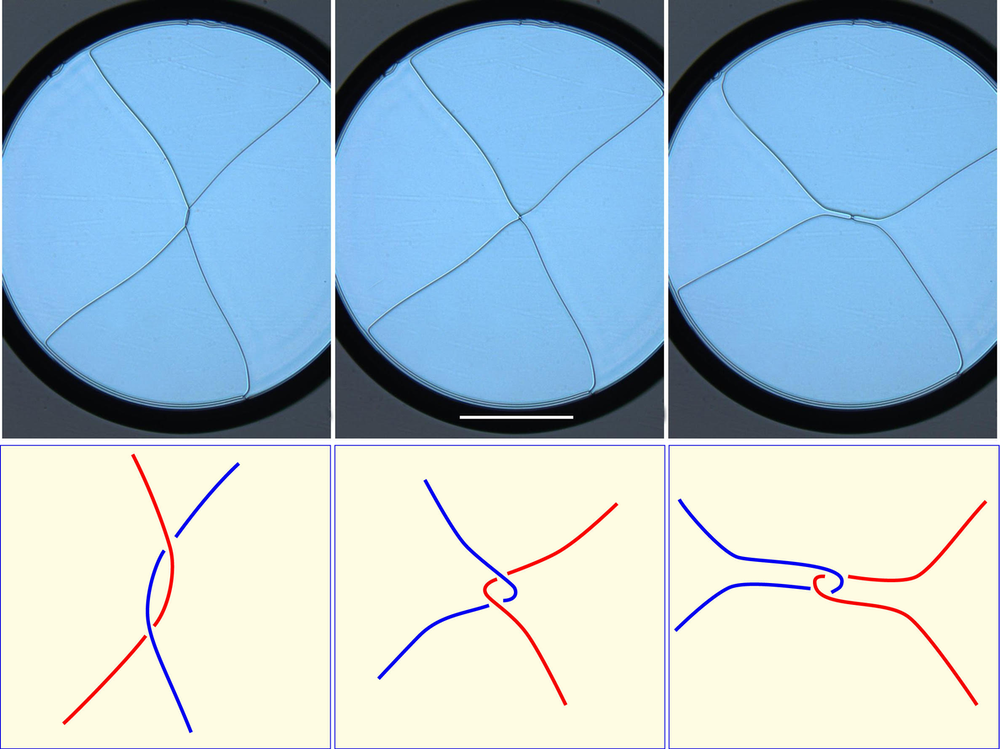Crystal Defects Interact to Form Intricate Structures
Systems made from ordered components, such as crystals, are often laced with defects, such as dislocations, where the ordering is disrupted. Researchers have now identified a new class of such flaws where two or more dislocations come together and become locked into complex geometrical arrangements, such as coils or knots, that can’t be smoothed away [1]. Using microscopy experiments backed up by theoretical arguments, they have identified such coiled “metadefects” in thin films of liquid crystals. The researchers believe that in crystalline materials, metadefects might influence mechanical properties such as plasticity. And since defects may feature in systems ranging from the structure of spacetime to magnets and bacterial colonies, the research team suspects that this new class may show up in other places.
Many liquid crystals are composed of rod-shaped molecules that can become oriented relative to one another while remaining free to move around. One of the phases that some of these materials can adopt is called cholesteric, a periodic pattern in which the orientation of the molecules twists like the steps in a spiral staircase. At each “step” of the staircase, all of the molecules are aligned. Defects in this organized structure typically show up as dark lines when thin films of cholesteric liquid crystals are examined under a microscope.
Defects strongly influence some properties of materials, so researchers are keen to know how they form and evolve. To study how cholesteric dislocations interact, Pawel Pieranski of the University of Paris-Saclay and his co-workers trapped 180-µm-thick films of cholesteric liquid crystals—thick enough to fit about ten twists of the cholesteric helix—between transparent mica sheets. The researchers generated dislocations, which in this case are linear defects along which regions of the film with different numbers of helical turns meet.
Two dislocations can move toward one another through a liquid-crystal film, like humps in a carpet, until they meet. One might naively expect molecules along the collision front to reorient so that the defects coalesce or annihilate, a little like kinks of opposite sign that cancel each other out. But there is a more stable arrangement, known since 2002, where the defects stick together in what is called a Lehmann cluster [2].
Pieranski and colleagues have now shown that the formation of a Lehmann cluster is just the first stage of the defect interaction. The defects then twist around one another like two strands of string, winding themselves into a tangle—a metadefect—at the core of which is a double helix. The researchers found that this coil is visible, end on, as a black dot between the two dark lines of the defects. “It took me a long time to understand what these black dots are,” Pieranski says. After the explanation became clear, “I realized that these tangles are quite ubiquitous.”
The metadefects act as distinct and robust objects, like knots, and can twist either to the right or to the left. In some cases, pairs of dislocations can twist into several metadefects along their length, creating a string of intersecting dislocations with bubble-like domains in between the points of intersection.
The researchers think that, in addition to coils, the dislocations could also become tangled into knots. “So far we have not succeeded in generating knotted dislocation loops,” says Pieranski, but he says that they have now found cases where the loops of a dislocation network can become interlinked like the links of a chain.
Pieranski says that the observations introduce a new general class of defect structures that in principle could appear in any of a wide variety of ordered systems. Metadefects might also explain some aspects of crystal mechanics, he says. The movement of dislocations through a lattice is the key process that determines the plasticity and ductility of metals, so if metadefects snag and hinder the motion of dislocations, they may affect these mechanical properties.
Slobodan Žumer, a specialist in liquid crystals at the University of Ljubljana in Slovenia, thinks these structures might find uses in optics and photonics: liquid crystals are widely used to manipulate light, and the metadefects might provide new ways of doing so. Theorist Mark Dennis of the University of Birmingham in the UK says that the concept of metadefects could find many applications. “Defects in other systems, such as turbulent superfluids, can be extraordinarily tangled, a situation also hypothesized for cosmic strings in the early Universe.”
–Philip Ball
Philip Ball is a freelance science writer in London. His latest book is How Life Works (Picador, 2024).
References
- P. Pieranski et al., “Topological metadefects: Tangles of dislocations,” Phys. Rev. Lett. 131, 128101 (2023).
- I. I. Smalyukh and O. D. Lavrentovich, “Three-dimensional director structures of defects in Grandjean-Cano wedges of cholesteric liquid crystals studied by fluorescence confocal polarizing microscopy,” Phys. Rev. E 66, 051703 (2002).





